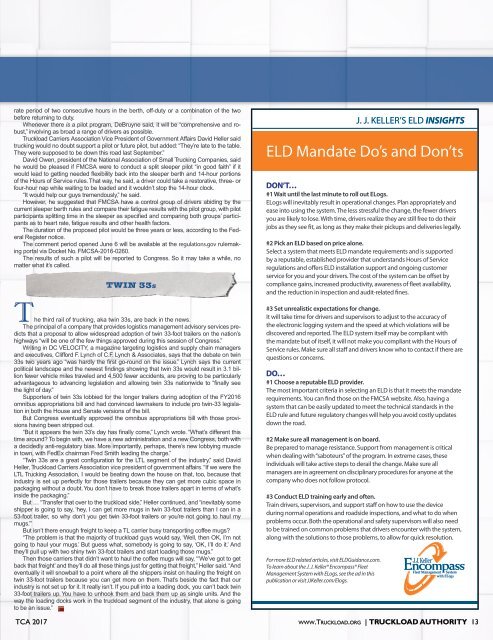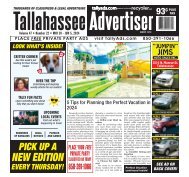TLA25_AllPages_R
You also want an ePaper? Increase the reach of your titles
YUMPU automatically turns print PDFs into web optimized ePapers that Google loves.
ate period of two consecutive hours in the berth, off-duty or a combination of the two<br />
before returning to duty.<br />
Whenever there is a pilot program, DeBruyne said, it will be “comprehensive and robust,”<br />
involving as broad a range of drivers as possible.<br />
Truckload Carriers Association Vice President of Government Affairs David Heller said<br />
trucking would no doubt support a pilot or future pilot, but added: “They’re late to the table.<br />
They were supposed to be down this road last September.”<br />
David Owen, president of the National Association of Small Trucking Companies, said<br />
he would be pleased if FMCSA were to conduct a split sleeper pilot “in good faith” if it<br />
would lead to getting needed flexibility back into the sleeper berth and 14-hour portions<br />
of the Hours of Service rules. That way, he said, a driver could take a restorative, three- or<br />
four-hour nap while waiting to be loaded and it wouldn’t stop the 14-hour clock.<br />
“It would help our guys tremendously,” he said.<br />
However, he suggested that FMCSA have a control group of drivers abiding by the<br />
current sleeper berth rules and compare their fatigue results with the pilot group, with pilot<br />
participants splitting time in the sleeper as specified and comparing both groups’ participants<br />
as to heart rate, fatigue results and other health factors.<br />
The duration of the proposed pilot would be three years or less, according to the Federal<br />
Register notice.<br />
The comment period opened June 6 will be available at the regulations.gov rulemaking<br />
portal via Docket No. FMCSA-2016-0260.<br />
The results of such a pilot will be reported to Congress. So it may take a while, no<br />
matter what it’s called.<br />
TWIN 33S<br />
The third rail of trucking, aka twin 33s, are back in the news.<br />
The principal of a company that provides logistics management advisory services predicts<br />
that a proposal to allow widespread adoption of twin 33-foot trailers on the nation’s<br />
highways “will be one of the few things approved during this session of Congress.”<br />
Writing in DC VELOCITY, a magazine targeting logistics and supply chain managers<br />
and executives, Clifford F. Lynch of C.F. Lynch & Associates, says that the debate on twin<br />
33s two years ago “was hardly the first go-round on the issue.” Lynch says the current<br />
political landscape and the newest findings showing that twin 33s would result in 3.1 billion<br />
fewer vehicle miles traveled and 4,500 fewer accidents, are proving to be particularly<br />
advantageous to advancing legislation and allowing twin 33s nationwide to “finally see<br />
the light of day.”<br />
Supporters of twin 33s lobbied for the longer trailers during adoption of the FY2016<br />
omnibus appropriations bill and had convinced lawmakers to include pro twin-33 legislation<br />
in both the House and Senate versions of the bill.<br />
But Congress eventually approved the omnibus appropriations bill with those provisions<br />
having been stripped out.<br />
“But it appears the twin 33’s day has finally come,” Lynch wrote. “What’s different this<br />
time around? To begin with, we have a new administration and a new Congress, both with<br />
a decidedly anti-regulatory bias. More importantly, perhaps, there’s new lobbying muscle<br />
in town, with FedEx chairman Fred Smith leading the charge.”<br />
“Twin 33s are a great configuration for the LTL segment of the industry,” said David<br />
Heller, Truckload Carriers Association vice president of government affairs. “If we were the<br />
LTL Trucking Association, I would be beating down the house on that, too, because that<br />
industry is set up perfectly for those trailers because they can get more cubic space in<br />
packaging without a doubt. You don’t have to break those trailers apart in terms of what’s<br />
inside the packaging.”<br />
But … “Transfer that over to the truckload side,” Heller continued, and “inevitably some<br />
shipper is going to say, ‘hey, I can get more mugs in twin 33-foot trailers than I can in a<br />
53-foot trailer, so why don’t you get twin 33-foot trailers or you’re not going to haul my<br />
mugs.’”<br />
But isn’t there enough freight to keep a TL carrier busy transporting coffee mugs?<br />
“The problem is that the majority of truckload guys would say, ‘Well, then OK, I’m not<br />
going to haul your mugs.’ But guess what, somebody is going to say, ‘OK, I’ll do it.’ And<br />
they’ll pull up with two shiny twin 33-foot trailers and start loading those mugs.”<br />
Then those carriers that didn’t want to haul the coffee mugs will say, “‘We’ve got to get<br />
back that freight’ and they’ll do all these things just for getting that freight,” Heller said. “And<br />
eventually it will snowball to a point where all the shippers insist on hauling the freight on<br />
twin 33-foot trailers because you can get more on them. That’s beside the fact that our<br />
industry is not set up for it. It really isn’t. If you pull into a loading dock, you can’t back twin<br />
33-foot trailers up. You have to unhook them and back them up as single units. And the<br />
way the loading docks work in the truckload segment of the industry, that alone is going<br />
to be an issue.”<br />
J. J. KELLER’S ELD INSIGHTS<br />
ELD Mandate Do’s and Don’ts<br />
DON’T…<br />
#1 Wait until the last minute to roll out ELogs.<br />
ELogs will inevitably result in operational changes. Plan appropriately and<br />
ease into using the system. The less stressful the change, the fewer drivers<br />
you are likely to lose. With time, drivers realize they are still free to do their<br />
jobs as they see fit, as long as they make their pickups and deliveries legally.<br />
#2 Pick an ELD based on price alone.<br />
Select a system that meets ELD mandate requirements and is supported<br />
by a reputable, established provider that understands Hours of Service<br />
regulations and offers ELD installation support and ongoing customer<br />
service for you and your drivers. The cost of the system can be offset by<br />
compliance gains, increased productivity, awareness of fleet availability,<br />
and the reduction in inspection and audit-related fines.<br />
#3 Set unrealistic expectations for change.<br />
It will take time for drivers and supervisors to adjust to the accuracy of<br />
the electronic logging system and the speed at which violations will be<br />
discovered and reported. The ELD system itself may be compliant with<br />
the mandate but of itself, it will not make you compliant with the Hours of<br />
Service rules. Make sure all staff and drivers know who to contact if there are<br />
questions or concerns.<br />
DO…<br />
#1 Choose a reputable ELD provider.<br />
The most important criteria in selecting an ELD is that it meets the mandate<br />
requirements. You can find those on the FMCSA website. Also, having a<br />
system that can be easily updated to meet the technical standards in the<br />
ELD rule and future regulatory changes will help you avoid costly updates<br />
down the road.<br />
#2 Make sure all management is on board.<br />
Be prepared to manage resistance. Support from management is critical<br />
when dealing with “saboteurs” of the program. In extreme cases, these<br />
individuals will take active steps to derail the change. Make sure all<br />
managers are in agreement on disciplinary procedures for anyone at the<br />
company who does not follow protocol.<br />
#3 Conduct ELD training early and often.<br />
Train drivers, supervisors, and support staff on how to use the device<br />
during normal operations and roadside inspections, and what to do when<br />
problems occur. Both the operational and safety supervisors will also need<br />
to be trained on common problems that drivers encounter with the system,<br />
along with the solutions to those problems, to allow for quick resolution.<br />
For more ELD related articles, visit ELDGuidance.com.<br />
To learn about the J. J. Keller® Encompass® Fleet<br />
Management System with ELogs, see the ad in this<br />
publication or visit JJKeller.com/Elogs.<br />
Fleet Management System<br />
with ELogs<br />
TCA 2017 www.Truckload.org | Truckload Authority 13

















